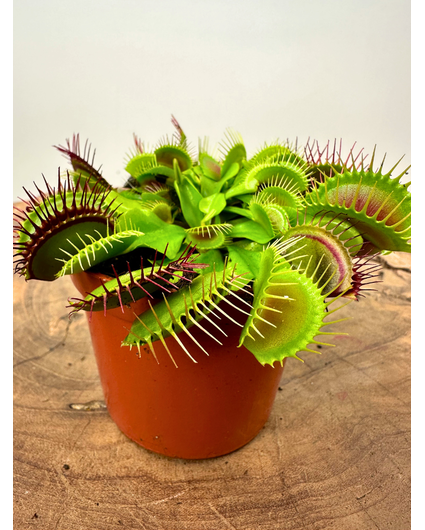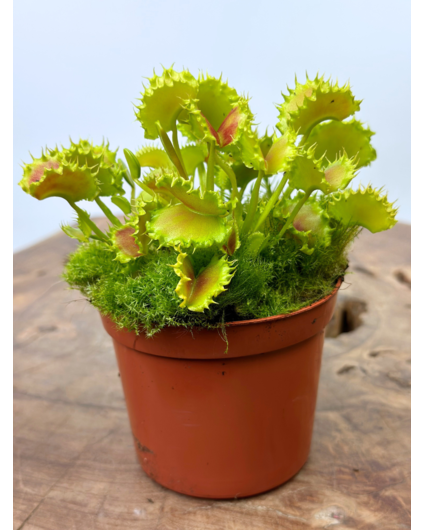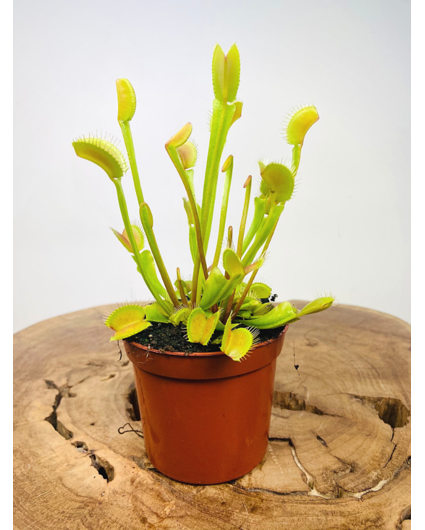Dionaea Muscipula (Venus fly trap)
Looking for a crazy carnivorous plant? The Venus fly trap is undoubtedly the most popular species... and we understand why! Discover this fantastic species here.
Dionaea Muscipula "G14" | ø 8,5 cm x ↕ 10 cm
INSECT-EATING PLANT
€ 12,99*
* Incl. tax Excl. Shipping costs
Dionaea Muscipula "The Zipp" | ø 8,5 cm x ↕ 10 cm
INSECT-EATING PLANT
€ 19,99*
* Incl. tax Excl. Shipping costs
Dionaea Muscipula - "The Red Dragon" | 8,5cm x ↕ 5 cm
INSECT-EATING PLANT
8% Save
€ 11,99 € 10,99*
* Incl. tax Excl. Shipping costs
Dionaea Muscipula - "Large" | ø 12 cm x ↕ 10 cm
INSECT-EATING PLANT
€ 13,99*
* Incl. tax Excl. Shipping costs
Dionaea Muscipula (Venus fly trap) 10 seeds
Quality & educational
€ 4,99*
* Incl. tax Excl. Shipping costs
Heat Packs
€ 1,80*
* Incl. tax Excl. Shipping costs
Dionaea Muscipula "light red" | ø 8,5 cm x ↕ 5 cm
INSECT-EATING PLANT
€ 9,99*
* Incl. tax Excl. Shipping costs
Dionaea Muscipula "red" | ø 8,5 cm x ↕ 5 cm
INSECT-EATING PLANT
€ 9,99*
* Incl. tax Excl. Shipping costs
Dionaea Muscipula | ø 8,5 cm x ↕ 15 cm
INSECT-EATING PLANT
10% Save
€ 9,99 € 8,99*
* Incl. tax Excl. Shipping costs
Care booklet - Carnivory.eu (English)
€ 0,50*
* Incl. tax Excl. Shipping costs

The Venus fly trap, Latin name (Dionaea Muscipula), is the only species in this family. However, the plant is related to the Sundew family. The Venus fly trap was first documented in 1760, whereupon its discoverer named this plant 'Fly Trap Sensitive'. The Venus fly trap, or Venus fly trap, is without doubt the best known carnivorous plant. With its famous leaves resembling a mouth, it is an iconic, beloved and impressive plant.
Dionaea Muscipula: The trap
The Venus fly trap catches small insects, such as flies and spiders, and is therefore called a carnivorous plant. The Venus fly trap catches insects with the so-called closing trap. The closing trap consists of two leaf halves, which together resemble a mouth. These leaf halves are designed in such a way that the halves close quickly in order to catch an insect. The scent of the leaf halves attracts the insects to the leaf. Inside the leaf, there are three to nine feeler hairs, which act as a kind of sensor. The touching of two feeler hairs within twenty seconds causes the 'mouth' of the Venus fly trap to close. After a successful catch, the mouth is filled with a digestive liquid in order to be able to digest the insect. The insect is digested within two to ten days. If the Venus fly trap closes without catching anything, the leaves will open again after a few hours. Important: it is, however, very bad for the plant to do this. It takes a lot of energy for the plant to close the trap.
After 10 times
The trap of the Venus fly trap can only digest a few insects. Thus, the Venus fly trap uses a leaf only 10 times. After these 10 times, the trap dies. But rest assured... the mouths serve purely as a source of nutrition for the plant. If a mouth dies (after successful catches), this means that the plant has enough nutrients to grow new mouths. This impressive plant can last up to 20 years with the right care. Do you want to know more about dionaea muscipula care? Then take a look at our care tips.
Venus fly trap origin
The Venus fly trap, like the pitcher plant (Sarracenia), originates from North America. Here the plant lives mainly in nitrogen-poor soil, such as marshes and peat bogs. Because there are virtually no nutrients in the soil, the Venus fly trap has developed the trap in order to still extract the necessary nutrients. The plant therefore does not get its nutrients from the soil, but from the insects.
Venus fly trap characteristics
The Venus fly trap grows to 10 centimetres. The plants grow low. The Venus flycatcher loves the sun. When the sun shines on the inside of the leaves, they turn a beautiful red. This makes them more attractive to insects. The Venus fly trap is a subtropical plant, which means that it can survive mild winters. In the winter, the plant is in hibernation. Care tip: it is therefore important that the Venus fly trap in your home also undergoes a winter rest. Read more carnivorous plant care tips.
Interesting facts
Did you know that wind or raindrops do not provoke a reaction from the Venus fly trap? This is because the drops and the wind are too slow. Moreover, it is a very clever plant. The plant seems to be able to count to two. Only when the feeler hairs on the leaves are touched twice within 20 seconds is it too late for the insect. The trap closes very quickly. Is there more than 20 seconds in between? Then the trap 'resets' itself. Clever, ruthless and impressive: the Venus fly trap (dionaea muscipula).
Want to buy another carnivorous plant? Check out our extensive range of carnivorous plants.











